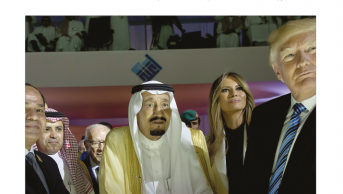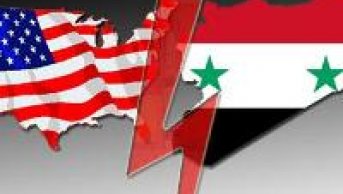Is the Arab Spring Turning into a Winter?
It has been two years since the outbreak of the Arab popular movements known as the Arab Spring.
These movements have changed many things and are continuing to do so. It is necessary to see that politics in the Middle East changes rapidly. In this period, while some Middle East countries are in the process of transition, others are still going through the pain of transition. Meanwhile, some countries are resisting transition. Regional and global powers are striving to reshape their foreign policies with regard to the region. In this process, new unexpected alliances are being formed. The democratic discourse, which emerged as a result of the collapse of dictators who had held power for a long time in Arab countries -- Tunisia and Egypt in particular -- has created a stir. However, the past two years have proved that the transition period is very difficult. Today there are many more obstacles in front of the Arab Spring compared to two years ago.
There are two developments in the Arab Spring that have killed the optimistic atmosphere that was there at the start. The first is the fact that developments in Syria have reached deadlock. Contrary to expectations, the transition in Syria was not like that in Tunisia, Egypt and even Libya. Over the past two years, the popular uprising in Syria turned into a civil war. This was a major crisis encompassing countries in the region and global powers. Thus Syria has become an arena both where domestic groups and countries in the region struggle with one another, and also where global power politics are being conducted. It would be by no means easy to reach a reasonable solution soon in a place with so many actors and where interests are so intermeshed. With each passing day the increasing violence in Syria leads to sharper polarization both in Syria and in the region. This situation is turning the spring that started in the region two years ago into a winter.
The second development leading to the loss of spring in the region is the developments that took place in Egypt and Tunisia during the second year of the revolution. Following the transition swept along by the popular movements, Islamist political parties/individuals that were excluded from politics for years in Tunisia and Egypt have become the major actors in the politics. In Tunisia, where the transition first took place, the Ennahda party won the elections. The winner of the elections held in Egypt, on the other hand, was the Muslim Brotherhood. The second political party after the Muslim Brotherhood was the Salafi al-Nour Party. Following the liberal coalition, they ranked second in the elections in Libya. As in the Syrian example, Islamists have the most organized structure among the opposition in countries experiencing the pains of transition.
Developments in Egypt and Tunisia in the second year of the Arab Spring are quite worrying. Demonstrations, which were staged against those dictators in power for years, are now being staged against Islamist powers. It should not be ignored that Islamist parties/individuals who have become the major actors of the political sphere in the post-transition period are the targets of various local groups and states. It appears that other than Islamists and a political structure/system with Islamic predominance would not be easily recognized by other groups and states in the region.
In fact, this is not a recent development. All kinds of attempts have been made to make Islamists fail and exclude them from the political sphere; take, for instance, the Islamist political party Islamic Salvation Front (FIS), which won the local elections held in Algeria in 1989 and the first round of general elections in 1990. Those in power in Algeria, supported by the army, would not let the second round of elections be held. The political tension turned into a conflict. Thousands of people were killed in the civil war that took place.
The Welfare Party (RP), which achieved great success in the 1994 local elections in Turkey, won the general elections held in 1995. However, that political party had to leave power as a result of a “postmodern” coup d’état in 1997. The Islamist party/organization that won the first free elections held in Palestine on January 2006 was Hamas. But the party was not given any chance to come to power. Add the developments in Egypt and Tunisia in the last two months to developments in regional politics since the end of Cold War, and it is clear that Islamists are prevented from writing a “success story.” In this context, differences/disputes as to what the new politics will be in the Middle East puts the transition process in a deadlock. Today, there are more obstacles before the Arab Spring compared to two years ago. Each group both inside and outside the country that cannot get what they expected from the new process is now striving to cause deadlock.
Internal obstacles
Leaders of the former regime: People and groups in power that have been taking advantage of the system with the support of the army for years do not want to give up their privileges. In fact, those groups/people are using every opportunity to prevent any transition. It is clearly seen that shrewd politicians of the established political order do not wish to leave the political and economic sphere they ruled for years. Those who cannot get what they expected in the new process: Those who initially supported the revolution but are unable to get what they wanted are also striving to undermine the process. Liberal and leftist groups that played an active role in the revolutionary/transition process did not receive the support they expected in the elections. The victory of Islamist parties in the elections led those groups to act in unison with leaders of the former regime. The groups who were openly staging demonstrations against dictators two years ago were split into two as seculars and Islamists. It seems it will take some time to overcome this situation. This secular-Islamist rift will be an important factor affecting the future of the Arab Spring.
Mistakes of Islamist parties: With the advantage of having the most organized structure, the Islamist groups/parties in the revolution process achieved some success in the elections held after the transition. But they lost the trust of the leftist, liberal and youth groups they acted in unison with in the demonstrations they staged during the transition process. The fact that Islamists want to become legalized and seize control in the political sphere as soon as possible constitutes another reason for the delay in the transition process. For Islamist parties to successfully manage the transition process, it is important to win the trust and support of revolutionary groups.
Regional obstacles
Regional rivalry: The rivalry among countries in the region is blocking the regional transition process. The most striking example of this is the rivalry between Iran and Saudi Arabia. Interest-based policies of countries in the region also bring about sectarian and ethnic polarizations. In particular, the developments in Syria within the last two years clearly show that realism loomed over the ideal of transition like a nightmare.
The attitude of monarchies: As in the examples of Tunisia, Egypt and Libya, the change of republican regimes as a result of popular movements initially made the monarchies happy. The aforementioned republican regimes were established in the 1960s by toppling monarchies with the effect of Arab nationalism in 1950. The collapse of republican regimes, with which monarchies had for years been having problems, through a new wave of transformation is important for them. But the fact that Islamists started to control the political sphere in a way that affects the future of monarchies in the post-transition process in the Arab world for two years has made them worry all over again. It might be suggested that the strengthening of the Muslim Brotherhood in several countries in the region has spread fear among the monarchies.
Israel: The fact that Islamists, who do not have a positive approach or attitude towards Israel, started to gain control over the political sphere with the Arab Spring worries Israel. Israel does and will do its best to prevent Islamists having a strong social base, from reaching their goals and from succeeding in the Middle East.
Global obstacles
Global powers that believe they will be negatively affected by the transition in the Middle East are striving to either impede or direct the transition in line with their own interests. Taking the experience in Libya into consideration, Russia believes that it has been negatively affected by the transition in the Middle East for the last two years and is taking a stand against the transition, and thus it supports Bashar al-Assad.
On the other hand, the US has considered the popular movements legitimate right from the start of the Arab Spring and has declared its support for the transition, although currently it is having some doubts about the new politics. To keep the transition under control and prevent a political structure it does not want or cannot cooperate with, the US is following the process carefully and taking steps accordingly. For example, it is not giving full support to the opposition forces in Syria due to the fact that it cannot be sure about their structure and their approach towards Israel. A transition without global support would not be easy. Hence, the transition deadlock in Syria clearly shows the need for support against global obstacles.
Conclusion
It seems today the obstacles before the Arab Spring are more than there were two years ago. Rifts among revolutionary groups, regional rivalry and global conflicts of interest have come to the forefront as developments that negatively affect the future of the Arab Spring. It is clear that the new political elite will have a hard time ahead to manage the transition










